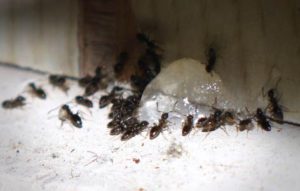INDOOR ANTS MAY REALLY BE OUTDOOR ANTS!
By Zachary Ciras on July 9, 2020.
Yes, the early ant season is well underway with calls about trailing ants that have suddenly appeared indoors and seem reluctant to leave. People say they’ve never had to deal with ants like this. Perhaps…but the fact that people are home more than ever now and bonding with their environment could mean they are noticing things that were overlooked before.
Indoor ant problems can be temporary and of the nuisance pest variety, or they can be serious as in the case of destructive carpenter ants. In most every case, ant problems are seasonal, triggered by weather changes, food availability, and the growing needs of the colony (see Why Do I Have Ants in My House?). Foraging ants are very fickle. Those hundreds of ants that seem to be taking over your kitchen today could be completely gone tomorrow, having moved on to better things.
VISITING ANTS OFTEN HAVE AN OUTSIDE HOME
In many cases, foraging ants enter a home from outside while in the process of scouting for food. If a scout ant finds a yummy crumb or two, it will carry some back to the colony, leaving a scent trail as it goes, and will recruit other ants to share in the bounty. Soon, many ants are trailing one behind the other back and forth, taking food from your house to feed others back in the colony. If this foraging behavior isn’t disrupted, it can go on for many days as long as the food is available.
This behavior is why toxic ant baits can work to eliminate an entire colony. When special baits are placed along the ants’ trails, they will carry the toxic food bait back to feed others in the colony.
BUT, THE ANTS COULD BE LIVING INSIDE INSTEAD
Ants that are not nesting inside can be fairly easy to eliminate or at least deter. However, sometimes the ant nest is actually inside your home or in a crawlspace or foundation. Nests can be in wall or ceiling voids, behind baseboards or window moldings, in stacks of newspaper or in potted plants, even inside a curtain rod. Controlling these indoor ants means first finding the nest, or nests (see Where Do Ants Nest Indoors?). In some cases, an outdoor ant colony may have an indoor satellite nest with ants commuting between the two.

Odorous House Ants eating gel bait which will eliminate the colony. Z. Ciras
Ants that are nesting inside often choose spaces that have high moisture levels. Carpenter ants are known for nesting in water-damaged wood, but other little nuisance ants often do the same thing. The difference is that carpenter ants chew out the wood to create their galleries and can cause considerable damage, while other ants generally nest in a void space without excavating the wood (see Should You Be Worried About Carpenter Ants?).
WE CAN ELIMINATE THE ANTS, WITH YOUR HELP
If you have an ant problem, give Colonial Pest a call. Out experts can determine the species of ants and whether they are nesting inside or outside. We can set up a control program that will eliminate the foragers and keep ants out.

Carpenter Ant with food. Z. Ciras
Our technicians will need your help though. Ants are in your home because they have been attracted by food (people or pet food, or something as simple as stored grass seed or dead insects), or by ideal nesting conditions such as damp wood. There are steps you can take to discourage ants: How to Keep Ants Out of Your Home.
For more detailed information on dealing with household ants, listen to our audio tutorial, Summer Pests: Ants.